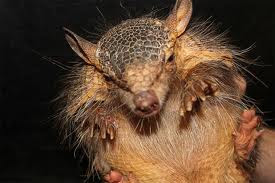I think these "little armoured animals" are really cute, especially the Pink Fairy Armadillo (you will read more on the different species of armadillos later on). Now, without further ado, I present you with this amazing animal: the armadillo.
There are twenty species of armadillos currently not extinct - and all of them live in the Americas. It's a shame they don't come over here to Ireland. I would have loved to have one as a pet! The largest species of armadillos, the Giant Armadillos can grow up to 1.5 metres in length and can weight up to 60kg.
The armadillo is considered a living fossil of sorts, mainly because it's the only living member of the Cingulata order - armoured animals.
The name armadillo is a Spanish one, given to the animal by Spanish Conquitadors. It literally means "Little armoured one".
Some armadillos are called "hairy armadillos" because of the thick covering of hair and fur underneath the overlapping scales and on the belly. Armadillo scales are mainly known as "scutes", made of bone with a covering of horn. Armadillos are the only living mammals that have this protective armour. Although the armour protects the armadillo from predators, they are also very fast runners. They can reach up to a speed of 48 kilometres per hour, and can even outrun humans over short distances. On the other hand, armadillos have very poor vision which makes it very vulnerable to it's main predators: bears, wolves and coyotes. Did you know that the Nine-Banded armadillo tends to jump vertically when facing predators and the South-American Three-Banded armadillo can curl up into a ball to escape danger? Only that particular specie of armadillo can do so.
Armadillos are omnivores, but they mostly forage for insects. Other parts of their diet include snakes, worms, spiders, and frogs. They use their sharp claws to dig underground tunnels as their homes. They are very simple and have only one entrance, about the size of the armadillo so they can enter. Armadillos can sleep up to 16 hours per day, eating in the early morning. They mainly use their sense of smell to hunt to make up for their lack in eyesight.
Armadillos live in warm climates, including rain forests and grasslands, and mostly near bodies of water.
The life span of an armadillo varies from 4-12 years. Female armadillos give birth to a litter of about 4 armadillos, who stay in the burrow for around six months.
Armadillos are able to stay underwater for six minutes. They naturally sink in the water due to their heavy shells, but they can float on the water easily enough if they fill their lungs with air.
Now that I have the basic facts down, I will tell you a little of some of the different species of armadillos there are. My personal favourite is also the Pink Fairy armadillo, because they are too amazing to not be my favourite. Which one is yours?
Giant Armadillo
This giant armadillo is extremely sleepy! They can sleep for up to 18 hours a day, and don't like to leave their burrows very much.
In contrast to their look, with the long, sharp claws and heavy armour, these creatures are very easily scared! It doesn't take very much for them to be frightened, and they will run back to their homes ones any danger is sensed.
Hairy Armadillos
Every one of the three hairy armadillo species - The Big Hairy armadillo, The Screaming Armadillo and the Andean armadillo - live in South America. They are very well named for the hairy bellies and the hairs sticking out from under the armoured scales they have.
Pink Fairy Armadillo
The Pink Fairy Armadillos are the smallest of all armadillos being only about 12-15 cm. The are also the only ones to have such coloured armour!
They have pleasant pink rose coloured looking armour - sometimes more yellow or even light brown in colour - and white fur underneath, on their bellies. Their diet consist of ants and ant larvae, worms, and other vegetation.
They are only found in grasslands in Argentina, and in sandy plains. Their claws help them to navigate around their environment and also to get the food they need. The claws are also a very important advantage to their self defence systems; they are able to bury themselves in a matter of seconds if they are in danger.
The main predator of the Pink Fairy armadillo are domestic dogs. They also live beside large ant colonies, as that is their preferred source of nutrition. They mainly come out to feed at night.
I thank you very much for reading all of this if you did! Please let me know if I have any information that is wrong up here: I don't want to lead you in the wrong direction! Now, What exactly have we learned about armadillos today? Tell me what was your favourite part/s of it, and what you found surprising and interesting.
See you very soon,
Elvish Kitty. :)








No comments:
Post a Comment